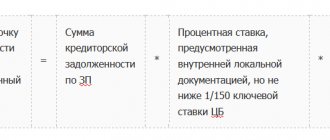Salary is not only a reward for the achieved results of work. Its functions also include a motivational and stimulating component. Payment for similar work may vary significantly depending on various factors. Why are there differences in pay? How can they be classified? What are the consequences of wage differentiation (hereinafter referred to as wage differentiation)? Let's analyze it in the article.
What are the features of differentiation and discrimination in wages?
What is wage differentiation?
Wage differentiation is the deliberate establishment of remuneration for work at different levels depending on specific factors. It is typical for markets in all countries and all sectors of activity.
Labor Code of the Russian Federation in paragraph 1 of Art. 129 states that the amount of remuneration directly depends on the qualities of the employee himself (qualification) and the properties of the work performed (complexity, volume, working conditions, etc.). It is impossible to find absolutely identical workers and identical employers. Therefore, the differentiation of payments is quite reasonable:
- the state strives to increase the well-being of its population;
- for the employer to increase the profit of the enterprise, increasing labor productivity, stimulating employees;
- workers satisfy their own and family needs at the expense of their salaries, that is, they provide for their lives.
NOTE! Pay may vary between employees of the same enterprise (internal differentiation), as well as between employees of different organizations.
Wage differentiation is an integral component of any developed society.
Question: How are basic salaries (basic official salaries), basic wage rates established for professional qualification groups of workers, taking into account their differentiation depending on the qualifications and complexity of the work performed? View answer
Correct selection of the optimal system
There is no ideal wage system in Russia and in the world. It is necessary to use several types in order to retain qualified specialists and get rid of those who are not ready to give their best.
So, in the sales department you should not set a high salary, since employees will try to fulfill only the plan. There will be no need to work beyond the norm unless the salary increases slightly. Those who do not want to work will leave because of the low salary. But experienced specialists who know how to sell can earn a lot from bonuses.
Employees responsible for document management must set a fixed amount. At the same time, it is necessary to carefully monitor the labor market so that the salary level remains average. Workers begin to quit when they realize that other companies can earn more for performing the same functions.
In production, it is worth using accruals that depend on output. In this case, you need to take into account the approximate profit from the products produced in order to understand how much you can charge for one unit of goods.
Factors of differentiation
Establishing a particular salary level is based on a number of factors that can be divided by importance into several groups.
Market factors
- The “demand/supply” ratio of certain labor markets reveals the most obvious and basic dependence of different wage rates. A market oversaturated with certain specialists will force their salaries to be lower, while rare professions that are in demand are traditionally paid highly.
- Investments in “human capital” show different quality of the workforce, and consequently, wages.
- The minimum wage is the minimum wage set by the state; it is the basis for many calculations regarding wages, that is, it determines its size.
How to calculate and process a salary supplement up to the minimum wage ?
Personal factors
- Demographic differences – different levels of pay depending on gender, age, race, nationality, appearance and other similar qualities. This does not mean different rates for people, for example, of different ages, but the fact that these properties give people different abilities to work. For example, hard physical work is not available to women, young people are able to work longer than older people, but do not have such experience, etc. As a result, people with different characteristics can expect different levels of pay for their work.
- Professional moments – directly related to paid activities, for example:
- education;
- experience;
- qualification;
- category;
- experience;
- specialization, etc.
- Social – related to the status of the individual in society. A person chooses a way to earn money based on the first two groups of factors - personal and professional characteristics. Employees of one or another professional status will have different levels of remuneration:
- entrepreneur;
- employee;
- executing the contract;
- freelancer;
- self-employed, etc.
- Economic features – influence the level of wages more significantly than others, since they are directly related to market factors:
- industry of work;
- occupation;
- employment options – full-time, hourly, part-time, etc.;
- working conditions (normal or difficult).
Territorial factors
- Geographical – climate conditions and natural features in which you have to work. The territory of the Russian Federation is vast and diverse, which determines the heterogeneous level of salaries in different regions.
- Industry - depending on which industry is leading in a particular region, the salaries of its residents will differ. For example, agricultural regions produce less profit than mining regions, so workers are not paid equally.
- Socio-political - factors that demonstrate the general standard of living in the country and separately in the regions. For example, political stability in different parts of the Russian Federation varies for a number of reasons, which also affects employment and wages. The cost of living also varies in different parts of the country.
- Institutional – associated with restrictions imposed by public institutions: trade unions and other organizations. For example, trade unions of individual workshops set a limit on membership in order to reduce the movement of workers to other regions where wages are higher - after all, they will not be accepted into the union there.
- Internal – related to the organization of work at the enterprise itself:
- salary policy;
- availability and features of financial incentives;
- working conditions and concern for their improvement;
- social guarantees, etc.
Types of salary differentiation
The differentiation of wages created by the above factors can be viewed from different points of view, which determines its types .
DZR by personnel categories
Employees are divided into certain categories, which take into account the level of their responsibility for work and, naturally, are reflected in their pay.
- Managers – the highest paid employees managing the organization, its structural divisions, as well as their deputies. The guidelines include:
- managers;
- managers;
- bosses;
- chairmen;
- chief accountants;
- captains;
- and etc.
- Specialists are employees who perform work that requires special education, higher or secondary, that is, they have graduated from a specialized educational institution in a certain specialty. Each profession has its own specialists: doctors, teachers, mechanics, managers, economists, etc. This category also includes assistants to persons in these specialties.
- Workers are employees directly involved in the production of products and the provision of services (transportation, transportation, repairs, etc.).
- Other employees - personnel involved in preparing and supporting activities, working with documentation, accounting, control, etc.
Sectoral and territorial differentiation
The structure of a country's economy results in different wages depending on these factors, analyzed in detail above.
DZR according to productivity and labor efficiency criteria
This is the most common and “visible” type of wage differentiation, when its size is determined by the quantifiable results of labor activity. This method of self-reporting has a stimulating function for employees of the organization, motivating them to more successful, high-quality and effective performance of work activities.
Requirements for incentive wage differentiation:
- personification;
- objective criteria;
- controllability;
- transparent and easy reflection in document flow;
- clarity for workers of all categories;
- positive impact on social protection.
Wage differentiation tools
How is wage differentiation implemented in practice? This goal is served, first of all, by the tariff system - a set of norms that determine a specific level of remuneration:
- rates;
- grids;
- qualification reference books;
- coefficients;
- allowances;
- surcharges, etc. tariff points.
Based on these standards, the employee’s rate or salary is calculated. An example of the functioning of the tariff system is the UTS, the Unified Tariff Schedule for budget employees of the Russian Federation.
Another way to form a salary is a system of official salaries , which regulates payment depending on certain indicators of the organization’s performance. It is more often used in government agencies or administrative enterprises, since it allows you to manage wages centrally.
Staffing schedules are standards developed by specific enterprises regarding the positions necessary for their functioning and the corresponding salaries. The staffing table may indicate fixed salary figures or a “fork” - the maximum and minimum wages for each given position.
Coefficients are indicators that affect the amount of wages depending on working conditions:
- climatic – regional coefficients;
- internal – a system of grades, that is, wage levels.
Other DZR tools:
- tariff-free payment system;
- floating salaries;
- commission payment;
- premium;
- piecework payment, etc.
IMPORTANT! Any principle of dividing wages into levels should depend, firstly, on a certain initial value (minimum wage, rate, minimum wage, etc.), and secondly, justification for the difference in levels based on social justice.
Coefficients and salary allowances
How to take into account and apply correctly. Subtleties and nuances
Many companies have their branches in the Far North and similar areas, so the problem of using the so-called “northern” coefficients is especially relevant for them.
This article will discuss various nuances in the application of regional coefficients and percentage allowances that an accountant, HR officer, or simply an ordinary company employee may encounter.
The need to apply regional coefficients and percentage bonuses to wages for work in the regions of the Far North and equivalent areas is established by Article 315 of the Labor Code of the Russian Federation (hereinafter referred to as the Labor Code of the Russian Federation).
In accordance with Art. 148 of the Labor Code of the Russian Federation, when performing work in areas with special climatic conditions, the employer is obliged to pay wages in amounts not lower than those established by labor legislation and other regulations.
Regional coefficients are established:
- Decrees of the Government of the Russian Federation (Article 316 of the Labor Code of the Russian Federation)
- Resolutions of regional, district and city administrations
- Regulatory legal acts adopted earlier (before the adoption of these resolutions to the present time (Article 423 of the Labor Code of the Russian Federation). In particular, the determination of the Cassation Board of the Supreme Court of the Russian Federation dated January 12, 2006 No. KAS05-612, letter of the Ministry of Finance of the Russian Federation dated April 12, 2006 No. 03 -03-04/1/334)
The percentage premium is set:
- Instructions on the procedure for providing social guarantees and compensation to persons working in regions of the Far North and in areas equated to regions of the Far North, in accordance with current regulations, approved by order of the Ministry of Labor of the RSFSR dated November 22, 1990. No. 2 (Hereinafter Instruction No. 2).
- Instructions on the procedure for providing employees of enterprises, institutions and organizations located in the Arkhangelsk Region, the Karelian Autonomous Soviet Socialist Republic, the Komi SSR as part of the RSFSR, in the southern regions of the Far East, the Krasnoyarsk Territory, the Irkutsk Region, as well as in the Buryat Autonomous Soviet Socialist Republic, the Tuva Autonomous Soviet Socialist Republic and the Chita Region, social guarantees and compensation in accordance with the resolution of the Central Committee of the CPSU, the Council of Ministers of the USSR and the All-Union Central Council of Trade Unions dated 04/06/72. No. 255, approved by order of the Ministry of Labor of the RSFSR dated November 22, 1990. (Hereinafter Instruction No. 3).
- By order of the Government of the RSFSR dated December 26, 1991. No. 199-r, which abolished restrictions on the maximum amount of employee income on which interest bonuses could be calculated.
- By the decision of the Supreme Court of the Russian Federation dated July 17, 2000. No. GKPI00-315
If the salary of an employee of an organization located in the Northern region consists of a salary, a bonus for length of service and a bonus, to which of these parts should regional coefficients and percentage bonuses be applied?
To all of the above. Regional coefficients and percentage bonuses are calculated on actual earnings, which include (according to the Explanations of the Ministry of Labor of Russia dated September 11, 1995 No. 3):
- official salary (salary at tariff rates) accrued to the employee for the time worked;
- bonuses determined by the remuneration system;
- allowances and surcharges to tariff rates;
- remuneration for length of service, paid monthly, quarterly or one-time (Letter of the Ministry of Health and Social Development of Russia dated February 16, 2009 No. 169-13);
- payment for overtime and night time, as well as work on weekends and non-working holidays;
- payment for downtime (for reasons beyond the control of the employee or the employer).
Restrictions associated with the maximum amount of earnings for which regional coefficients and percentage bonuses were to be applied were legislatively abolished back in 1991 (by order of the Government of the RSFSR dated December 26, 1991 No. 199-r). Thus, the specified coefficients must be calculated for the entire amount of actual earnings without restrictions.
Please note: even if the employment contract with the employee or any other regulatory act of the employing organization located in the Far North region or an equivalent area, it is expressly stated that the regional coefficient does not apply or does not apply to the entire amount of the employee’s income, for example, only to the salary, such an entry may be challenged in court. After all, according to the general rule, the norms of local regulations that worsen the situation of workers in comparison with the established labor legislation, collective agreement or other regulatory documents are not applied (Article 8 of the Labor Code of the Russian Federation, Determination of the Moscow Regional Court dated 04.05.2010 N 33- 6620).
In addition, for violating labor laws, an administrative fine in the amount of 1,000 to 5,000 rubles may be imposed on the head of the company, and from 30,000 rubles on the organization. up to 50,000 rub. or administrative suspension of activities for up to 90 days.
If the violation is repeated, and the official has already been brought to administrative responsibility under this article, then another measure may be applied to him - disqualification for a period of 1 to 3 years.
In addition to the fine, if the employer is held liable, he will be obliged to return the money not paid to the employee on time with interest for each day of delay, starting from the next day after the established payment deadline until the day of actual payment of funds, in the amount of 1/300 of the current amount at that time refinancing rates of the Central Bank of the Russian Federation.
If the Company is located in Moscow and has branches in the Far North, is it necessary to apply northern coefficients to the accrued wages of employees of such branches?
Yes need. Regional coefficients and percentage increases are applied at the place of actual work of the employee of the organization, regardless of the location of the head office.
This position was outlined by the State Committee for Labor of the USSR (clause 2 of the explanations of the State Committee for Labor of the USSR and the Secretariat of the All-Union Central Council of Trade Unions dated November 11, 1964 No. 15/30 “On the procedure for applying the conditions of remuneration established by the resolution of the Central Committee of the CPSU, the Council of Ministers of the USSR and the All-Union Central Council of Trade Unions dated July 15, 1964 No. 620 to individual categories of workers) and the Ministry of Labor of Russia (clause “a” of clause 5 of the Recommendations for concluding an employment agreement (contract), reflecting the specifics of regulating social and labor relations in the conditions of the North, approved by Resolution of the Ministry of Labor of Russia dated July 23, 1998 No. 29).
The tax office supports the same position. For the purpose of recognizing income tax expenses, labor costs include accruals based on regional coefficients and coefficients for work in difficult natural and climatic conditions (clause 11 of Article 255 of the Tax Code - hereinafter referred to as the Tax Code of the Russian Federation). At the same time, according to Art. 252 of the Tax Code of the Russian Federation, expenses are recognized as justified and documented expenses incurred by the taxpayer.
As a documentary justification, the tax department puts forward 2 criteria: 1) the calculation of regional coefficients and percentage allowances must be fixed in employment contracts; 2) the organization must have documentary evidence of the employee’s labor activity in a branch (separate unit) located in the regions of the Far North or equivalent areas.
In the event that an employee is hired to work in a branch, representative office or other separate structural unit of the organization, as an additional mandatory condition for recognizing labor costs, it becomes necessary to include in the employment contract a condition on the place of work indicating the separate structural unit and its location (Article 57 Labor Code of the Russian Federation).
If these conditions are met, the Organization will be able to take into account, for profit tax purposes, the costs of remunerating these employees, taking into account regional coefficients legally established for a given area and currently in force. (Letter of the Federal Tax Service dated October 22, 2009 No. 3-2-09/223, letter of the Department of Tax Administration of Russia for Moscow dated January 29, 2001 No. 03-12/3562.)
And if the employee does not permanently work in a structural unit located in the Far North or equivalent areas, but is temporarily sent there by the parent organization to perform an official assignment. Is it then necessary to calculate the regional coefficient used to calculate the income of employees of a given structural unit?
No need. If an employee is sent on a business trip from another location, the regional coefficients established at the place of business trip do not apply to the salary of such employees (clause 4 of Instruction No. 2).
Such employees retain the average earnings at their main place of work (Article 167 of the Labor Code of the Russian Federation) using the regional coefficient that is applied at the location of the parent organization that sent this employee on a business trip. (clause “l”, clause 2 of the Regulations on the specifics of the procedure for calculating average wages, approved by Decree of the Government of the Russian Federation dated December 24, 2007 No. 922).
If an employee has a traveling nature of work and is forced to regularly move between branches located in territories with different regional coefficients, how then to calculate his salary?
Proportional to the time worked using northern coefficients during work in the northern regions. Sometimes situations arise when, during the year, an employee performs his current job duties both in areas where regional coefficients and allowances are applied, and in ordinary areas. For example, with the traveling nature of the work.
In this case, appropriate guarantees and compensation will be applied in proportion to the time worked in such areas. (Decision of the Supreme Court dated May 6, 2011 No. 78-B11-16.) This means that the employer has an obligation to separately record days worked in territories with different regional coefficients.
To do this, additional columns are introduced into the unified forms of working time sheets (No. T-12 and T-13). Changes are formalized by order of the head of the employing organization. (The procedure for applying unified forms of primary accounting documentation, approved by Decree of the State Statistics Committee of Russia dated March 24, 1999 No. 20.)
However, then it is necessary to register the traveling nature of the employee’s work in his personal employment contract (Article 57 of the Labor Code of the Russian Federation), and also enter his position into the list of jobs, professions, positions of employees whose permanent work is of a traveling nature, securing it with a collective agreement, orders and other local regulations (Article 168.1 of the Labor Code of the Russian Federation). In this case, the employee’s business trips will not be registered as business trips (Article 166 of the Labor Code of the Russian Federation).
If an employee lives in an area where district coefficients do not apply, but is employed by a company located in an area where such coefficients are applied (for example, home-based workers), should multiplying factors then be taken into account when calculating their income?
Yes need. In this situation, it is worth following the resolution of the State Committee for Labor of the USSR and the Secretariat of the All-Union Central Council of Trade Unions dated July 2, 1987. No. 403/20-155. As the main criterion for the application of regional coefficients and bonuses to an employee’s salary, this resolution identifies labor activity in the relevant area, and not the employee’s place of residence or registration. The resolution does not contain other criteria for the payment of regional bonuses.
An employee working in a branch of an organization located in an area equated to the regions of the Far North went on maternity leave. Is it necessary to apply a regional coefficient to the monthly child care allowance?
If the benefit is calculated based on the employee’s salary, which was determined using the specified coefficient, then there is no need to increase the benefit.
If the monthly benefit is paid in an amount that does not exceed the minimum wage established by federal law for a full calendar month (for example, if the employee’s insurance coverage is less than 6 months), then the regional coefficient must be applied (Article 5 of Federal Law No. 81-FZ “On state benefits for citizens with children”).
The company's employees work in different branches of the company. One is located in Krasnoyarsk, the other in Novosibirsk. Are they entitled to additional leave due to their work in the far north?
For employees of the Krasnoyarsk branch - required.
For employees of the Novosibirsk branch - not allowed.
In accordance with Art. 14 of the Law of the Russian Federation of February 19, 1993. No. 4520-I “On state guarantees and compensation for persons working and living in the regions of the Far North and equivalent areas” (hereinafter referred to as Law No. 4520-1), in addition to the additional leaves established by labor legislation, provided on a general basis to employees of companies located in territories with a particularly harsh climate, additional annual additional leave is established as compensation lasting:
- 24 calendar days – for regions of the Far North;
- 16 calendar days – for equivalent areas;
- 8 calendar days - for other Northern regions, where a regional coefficient and a percentage increase in wages are established.
It literally follows from this article of the law that employees of organizations located in areas in which regulations establish a regional coefficient and a percentage increase are provided with additional annual paid leave: 8 calendar days.
This point of view is supported by the Supreme Council of the Russian Federation. In paragraph 3 of its Resolution dated February 19, 1993. No. 4521-1, he announced that all state guarantees and compensation provided for by Law No. 4520-1 apply to companies located in the regions of the North (not related to the regions of the Far North and equivalent areas), where the regional coefficient is also established , and a percentage increase in wages.
Since the cities of Krasnoyarsk and Novosibirsk belong only to the Northern regions, employees of branches will be entitled to additional leave if regional coefficients and percentage increases are provided for the cities of Krasnoyarsk and Novosibirsk.
By its resolution No. 311-P, the administration of the Krasnoyarsk Territory established a regional coefficient of 1.3 instead of the previously valid coefficient of 1.2. This coefficient is valid for all enterprises and organizations of the region, regardless of the form of ownership (Resolution No. 311-p of August 21, 1992 “On establishing the regional coefficient”).
The legality of applying the coefficient of 1.3 in this area is confirmed by judicial practice (Resolution of the Federal Antimonopoly Service of the East Siberian District dated May 29, 2008 No. A33-15507/2007-F02-2142/2008).
By virtue of clause 1 of the resolution of the Council of Ministers of the USSR and the All-Union Central Council of Trade Unions of September 24, 1989. No. 794 “On the introduction of salary bonuses for workers and employees of enterprises, institutions and organizations located in the southern regions of the Irkutsk region and the Krasnoyarsk Territory” for continuous work experience for employees of enterprises located in the southern regions of the Krasnoyarsk Territory (including in the city of Krasnoyarsk ) a 10% bonus is due for the 2nd year of work with an increase of another 10% for each subsequent 2 years of work, but not more than 30% of earnings (clause 1 of Instruction No. 3).
Thus, employees working in a branch located in Krasnoyarsk, in addition to the additional leaves established by labor legislation and provided on a general basis, are entitled to an additional 8 calendar days of leave as compensation.
For the city of Novosibirsk, by decision of the regional administration and the Decree of the Government of the Russian Federation, an increased regional coefficient of 1.25 was established. (clause 1 of the Decree of the Administration of the Novosibirsk Region dated November 20, 1995 No. 474 “On the introduction of an increased regional coefficient of wages in the region” from 01/01/1996, clause 17 of the Decree of the Government of the Russian Federation dated May 31, 1995 No. 534 “On Measures to solve urgent problems of stabilizing the socio-economic situation in the Novosibirsk region").
However, the legislation does not provide for a percentage increase in wages for the city of Novosibirsk.
Thus, despite the fact that Novosibirsk is located in the Northern region and employees of organizations located there are entitled to a regional coefficient for working in harsh climatic conditions, additional calendar days of vacation for working in the northern territories are not provided for by law.
It is worth noting, however, that employers can establish additional leaves for their employees on their own, unless their decision contradicts labor legislation (clause 2 of Article 116 of the Labor Code of the Russian Federation). The main thing is not to forget to specify the procedure, conditions and duration of such leaves in collective agreements or local regulations adopted taking into account the opinion of the elected trade union body.
The company's branches are located in Omsk, Vladivostok, Ufa and other large Russian cities. Where can I see the value of regional coefficients and percentage premiums for these places?
The departments of the Ministry of Labor and the Pension Fund of Russia issued an Information Letter, which indicated the sizes of Regional coefficients for a number of districts and regions on the territory of the Russian Federation (Information Letter of the Department of Population Income and Living Standards of the Ministry of Labor of the Russian Federation, the Department of Pension Issues of the Ministry of Labor of the Russian Federation and the Department of Organization of Assignment and payment of pensions to the Executive Directorate of the Pension Fund of the Russian Federation dated May 19, June 9, 2003 NN 670-9, 1199-16, 25-23/5995).
In the reference and legal system Garant you can also find Certificates on regional coefficients for wages, ranging from relatively recently issued Government Resolutions and Decrees of the President of the Russian Federation, ending with Resolutions of the Council of Ministers of the USSR and the State Committee for Labor of the USSR and the Secretariat of the All-Union Central Council of Trade Unions, which are valid insofar as they do not contradict the legal regulations documents of ministries and departments of the Russian Federation.
(Resolution of the Government of the Russian Federation dated April 17, 2006 N 216 “On regional coefficients used in establishing labor pensions and state pensions for persons living in the Far North and equivalent areas, as well as in areas with severe climatic conditions” ).






